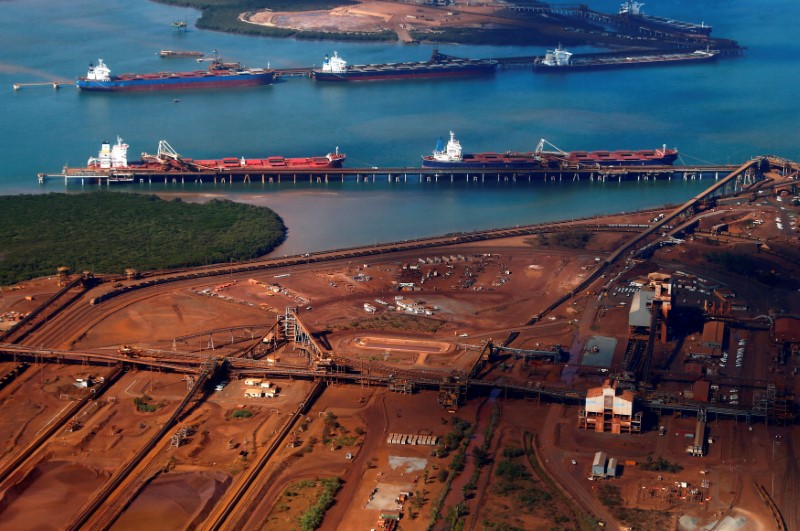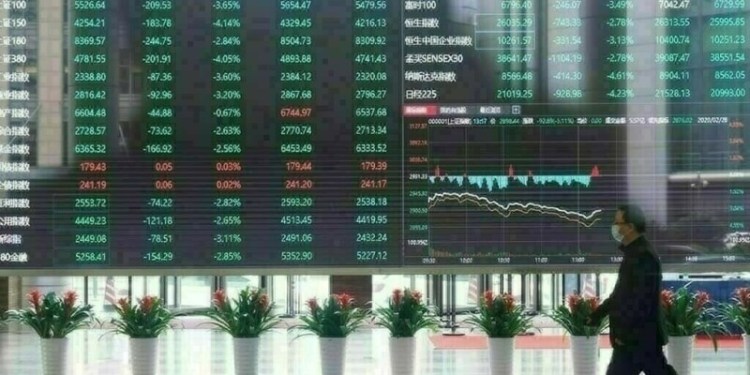 © Reuters. FILE PHOTO: File picture of ships waiting to be loaded near piles of iron ore and bucket-wheel reclaimers at the Fortescue loading dock located at Port Hedland
© Reuters. FILE PHOTO: File picture of ships waiting to be loaded near piles of iron ore and bucket-wheel reclaimers at the Fortescue loading dock located at Port HedlandBy Melanie Burton
MELBOURNE (Reuters) – Australia’s government expects the nation’s resource and energy exports to hit a record of A$252 billion ($182 billion) in 2018-2019, buoyed by climbing prices for commodities such as and by a weaker Australian dollar.
However, the country’s Department of Industry also said in a report that the value of such exports would edge back to around A$238 billion in 2019-2020 even as volumes rise again, pulled down as growing global supply and concerns over demand pressure prices. The figure for 2017-18 was A$227 billion.
“While global economic growth, industry production and manufacturing output have continued to grow strongly so far in 2018, there are some concerning signs for resource and energy commodity producers, particularly with rising global trade tensions,” the department said in the report, released on Tuesday.
China and the United States have been bogged down in a tit-for-tat trade dispute that has hit global markets and stoked worries over the outlook for the global economy.
China buys just over half of Australia’s commodity exports, followed by Japan, then South Korea.
Australia expects prices for steelmaking material iron ore to fall to around $52 a ton on a free on board basis in the 2019 calendar year and $51 a ton in 2020, as China’s steel production moderates, down from $59.40 this year.
Still, Australia’s iron ore exports are expected to increase to 878 million tons in 2019-2020 from 869 million tons this financial year and 849 million tons in 2017-2018, driven by a ramp up in production from the country’s largest producers.
But the overall value of iron ore exports is expected to drop to $56 billion in 2019-2020 from $61 billion in 2017-18.
The government said prices for metallurgical coal would average $159 a ton in the 2019 calendar year, trimming a forecast drop to $156.80 that it made in June. That would also be down from the $201 a ton it sees for 2018.
It also said that prices for the commodity would average $145 a ton in 2020, less than an earlier forecast of $147.90.
For the first time, the department offered an outlook for lithium, used to make batteries for electric cars. Australia accounts for 17 percent of the world’s lithium production.
Australia’s exports of spodumene, the raw material for lithium, are expected to rise to around $1.1 billion by 2020, from $780 million in 2017 and $117 million in 2012.
Five large plants are planned or under construction in the state of Western Australia that will turn spodumene into intermediate products for the lithium industry such as lithium carbonate or hydroxide.
That investment pipeline will ensure Australia shifts rapidly beyond concentrate production to becoming a refiner of “significant scale” by the early 2020s, the government said.
Fusion Media or anyone involved with Fusion Media will not accept any liability for loss or damage as a result of reliance on the information including data, quotes, charts and buy/sell signals contained within this website. Please be fully informed regarding the risks and costs associated with trading the financial markets, it is one of the riskiest investment forms possible.
Source: Investing.com



























